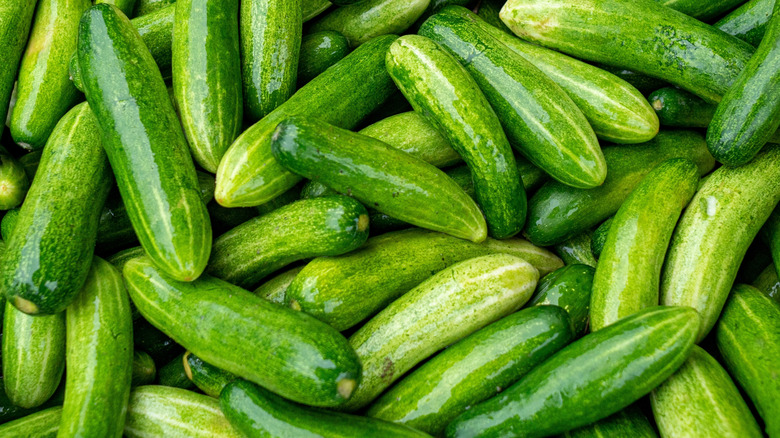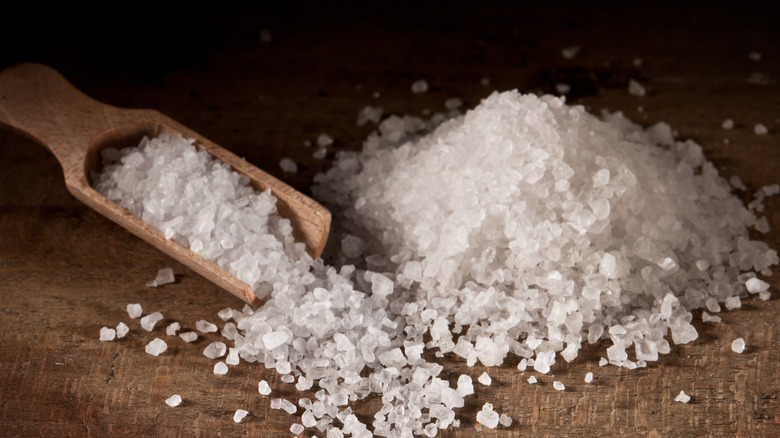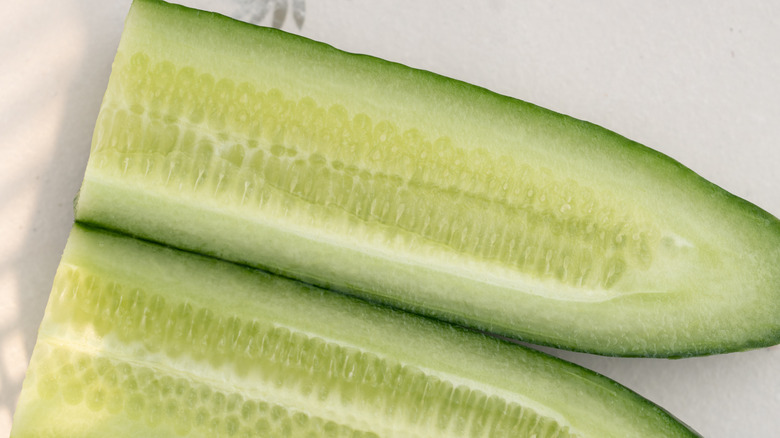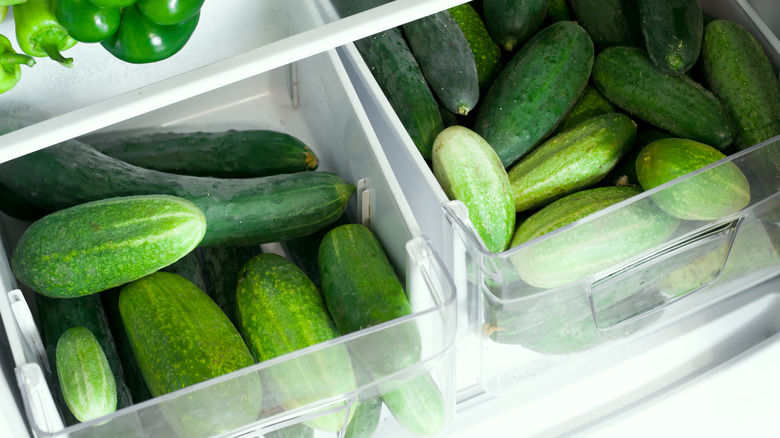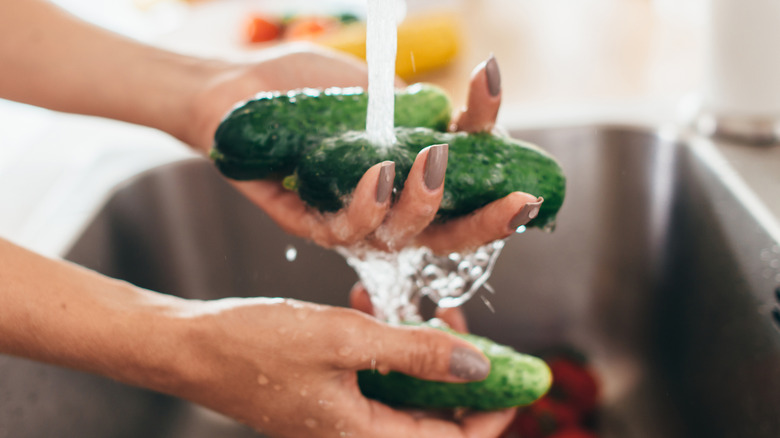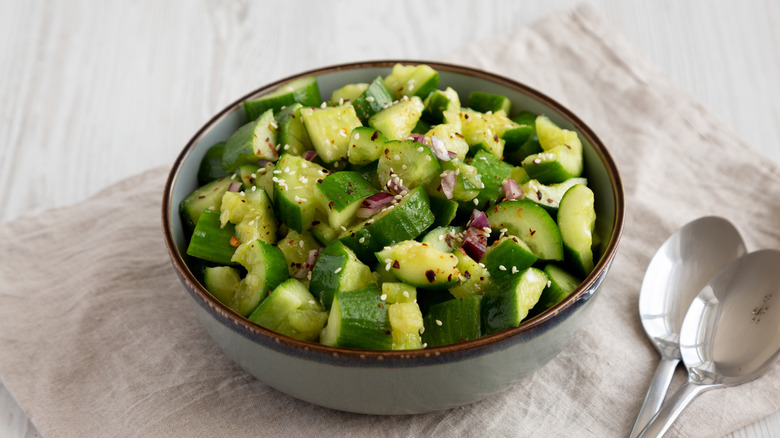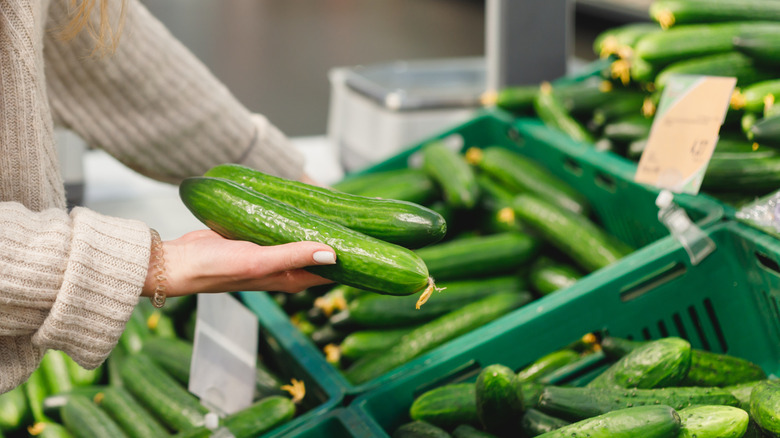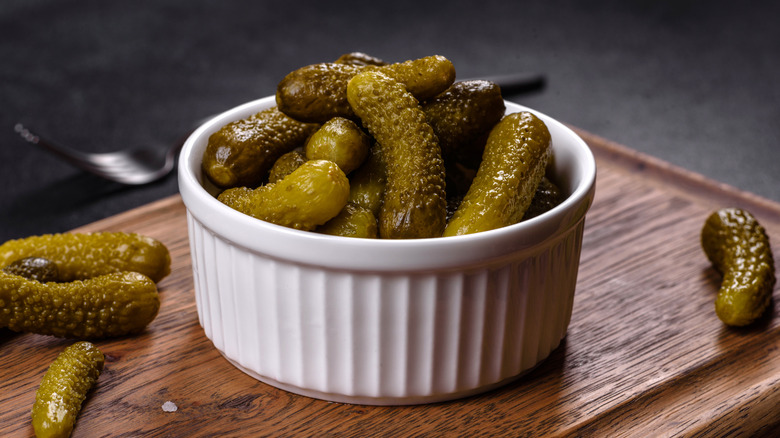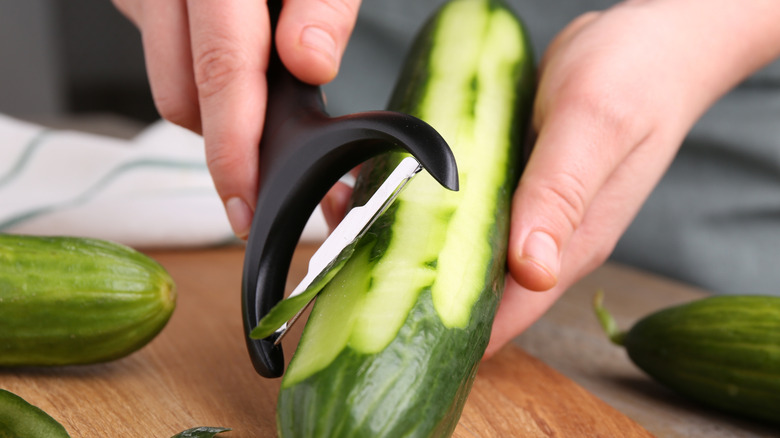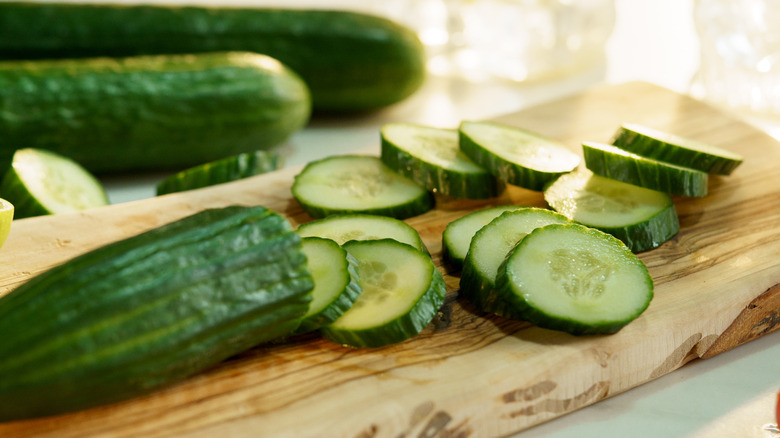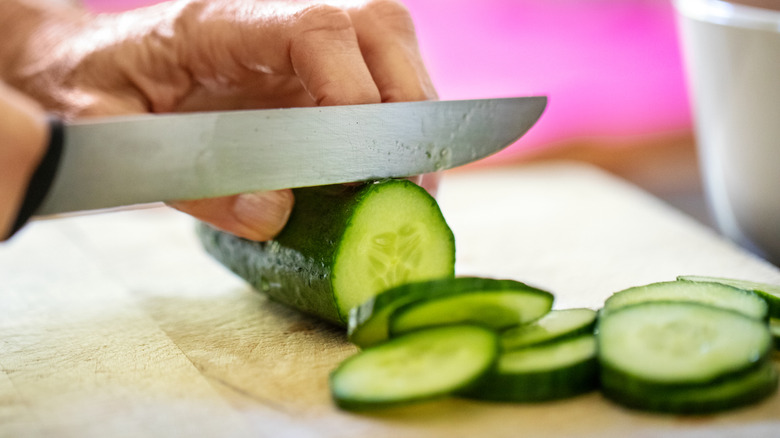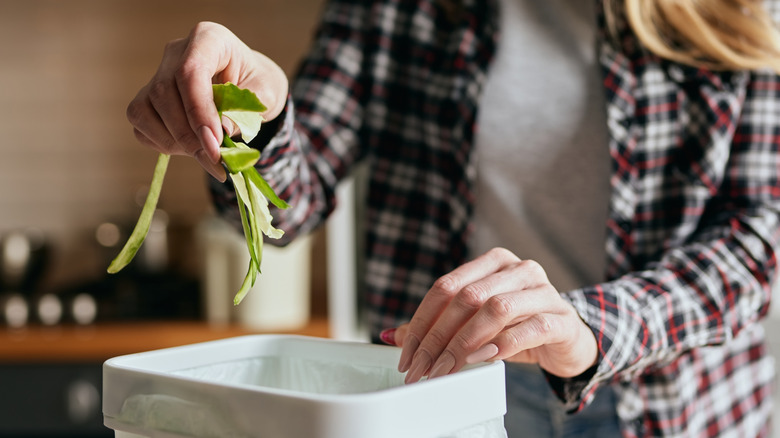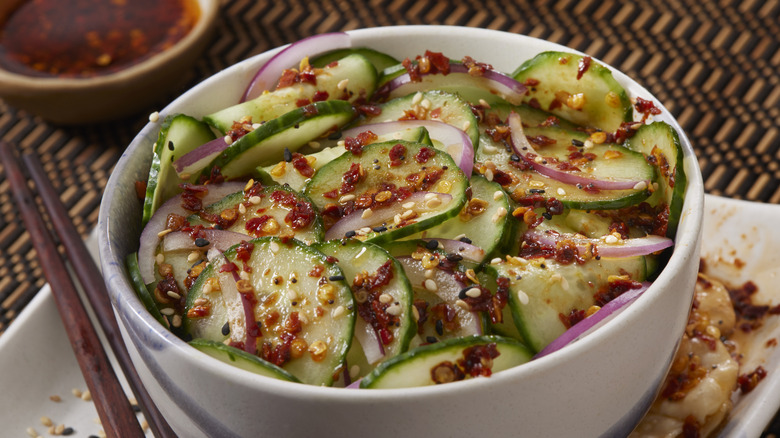12 Cucumber Mistakes You Don't Want To Make
Crisp and refreshing, cucumbers are a ubiquitous ingredient in households and restaurants around the world. Technically classified as a fruit (because they grow out of a flower and contain seeds) but often treated and prepared as a vegetable, their botanical relatives include watermelon, squash, and pumpkin. With a high water content and mild flavor that takes on practically any seasoning, cucumbers are conventionally used to add freshness and a crunchy bite to sandwiches an salads, while fermented preparations, i.e., pickles, line grocery store shelves year-round.
Relished (pun intended) for their cooling abilities and fresh taste, picky eaters usually cite slimy texture, bitterness, and an off-putting smell as the source of their contempt towards cucumbers. Like any food product, though, proper handling and skill can make a world of difference — and potentially win over the most skeptical of palates. In this article, we'll delve into common pitfalls and how to avoid them when choosing, storing, and cooking with cucumbers.
1. Not salting cucumbers
Don't sweat the small stuff — but do sweat your cucumbers. With a notably high water content at upwards of 95%, cucumbers can face an unwanted, soggy fate. For crisper cukes, just add salt. The addition of salt triggers the process of osmosis, which refers to the movement of water through a semipermeable membrane from an area of low concentration of solutes to a higher one. This reaction drives the excess moisture out of the cell walls, resulting in a firmer, less diluted cucumber that won't leach water into the finished dish, be it a salad, dip, or otherwise. Not a new concept by any means, salting is a long-practiced cooking technique amongst water-rich foods. Other veggies that benefit from this process include zucchini, eggplant, cabbage, and more.
Douse cucumbers with a healthy sprinkling of salt and let them sit for some time in a colander — around 30 minutes should be plenty. You'll notice water beading up on their surface, which you can then pat dry with a paper towel, or squeeze out with your hands over a bowl or the sink. Moreover, adding salt at the outset will kick start the seasoning process, with salt deeply penetrating ingredients from the get-go. A true win-win.
2. Not seeding cucumbers
The seeds and surrounding pulp account for a great deal of the moisture, bitterness, and unwanted texture found in cucumbers. For a quick fix to keep cucumbers crunchy, take Gordon Ramsay's advice and split them lengthwise and scoop out the seeds with a utensil. While cooking alongside his daughter, the star chef effortlessly demonstrates this using a teaspoon, explaining that he wants the dish to be crunchy and fresh, not soft. Another benefit to seeding cucumbers, in addition to preserving their crispness, is the multitude of handy applications such as, say, cucumber seed lemonade.
You can, of course, opt for a seedless cucumber to avoid this hassle altogether. While not entirely seed free, certain varieties such as English cucumbers, also known as hot house cucumbers, contain minimal seed content and thinner skin in comparison to their peers. Be mindful, though, as some types of cucumbers tend to work better for certain preparations than others due to their flavor profiles and textural elements.
3. Storing cucumbers improperly
Cucumbers thrive when stored at temperatures between 50 and 55 degrees Fahrenheit. This range falls slightly above the average refrigerator, which hovers around or below 40 degrees. When kept at these colder temperatures, cucumbers can develop what's known as a chilling injury, creating water-logged areas, pitting, discoloration, and decay. If you're worried you've been storing cucumbers wrong, some experts suggest keeping fresh cucumbers on the counter, or in an otherwise cool, dry location. Be sure to place them at a distance from ethylene-emitting fruits and veggies, like bananas and tomatoes, which can accelerate the spoilage process.
During warmer months, you may want to consider making use of your refrigerator's crisper drawer. Also referred to as a humidity drawer, these compartments are specifically designed for storing produce, as well as isolating fruits and veggies that require specific conditions or put other items at risk (see ethylene issue above). As the name suggests, crisper drawers offer a more controlled, humid environment than the rest of the fridge, which is particularly beneficial for thin-skinned or water-rich produce like cucumbers. Additional preventative measures include stashing cucumbers in a sealed plastic bag to retain humidity, alongside a paper towel or two to absorb the excess moisture. With that said, some cucumbers at the grocery store already come pre-shrink wrapped, and in that case it's best to keep them protected until you plan to use them.
4. Not cleaning cucumbers thoroughly
Animal products are not the only items susceptible to foodborne illnesses. Fresh produce can become contaminated just as easily if proper safety precautions are not taken every step of the way. Indeed, the CDC has reported several known cases of Salmonella linked to cucumbers. While ensuring that the proper safeguards are in place during growth and harvest is not within our control as consumers, there are a few simple measures that we can take from the point of purchase to help reduce any risk of getting sick.
First and foremost, wash your mittens. Like any doctor will tell you, keeping hands clean is the first and easiest defense at killing germs. Next, choose fruits and veggies that are intact, without bruising, odors, or unpleasant films. Cucumbers in particular are prone to sliminess, a good indicator of spoilage. The FDA recommends rinsing fruits and veggies prior to cutting, so that dirt and bacteria are not transferred from your knife or work surfaces. Give cukes a gentle rub down under running water to get rid of any particularly stubborn particles, or use a soft bristle brush. Dry completely with a clean cloth or towel. If any portion of the produce is damaged, you should cut those parts off. And lastly, try to avoid cross contamination with raw meat, poultry, or seafood – pay attention to sharing surfaces, utensils, and dishes. When in doubt, consult the CDC's food safety guidelines.
5. Only serving cucumbers raw
Yes, you can cook cucumbers. Though it might feel counterintuitive, cucumbers are wonderful in both cooked and raw preparations. Frequently relegated to lackluster salads, bland crudité platters, or as a reliable dip companion, these phallic friends have a versatility rarely explored by the average American home cook. Practically any cooking method you'd use on other vegetables can also be applied to cucumbers, whether it be charring, grilling, sauteing, baking, and so on. Whichever cooking adventure you choose, seeding and salting becomes essential in order to avoid the surplus of water that will be released with heat.
Like most other vegetables, the flavor of cooked cucumbers doesn't vary that drastically from their raw state. The texture, on the other hand, will evolve into a softer, more tender consistency as opposed to that aggressive, audible crunch we usually associate with cucumbers. Closely resembling zucchini, but not as dense or spongy, cooked cucumbers integrate well into a variety of dishes, adding an mellow, vegetal note. So the next time you're staring at a drawer full of cucumbers, don't just toss them into a salad. Instead, try a simple stir fry, or take a page out of Julia Child's book (we all should) and throw them in the oven with plenty of butter.
6. Choosing poor-quality produce
To get the most out of your cucumber experience, ripeness and quality are paramount. The ideal cucumber features a thin skin, juicy bite, and mild, slightly sweet flavor. To attain this, seek out firm cucumbers with consistent, dark green coloring throughout. As they ripen, cucumbers will develop light green or yellow spots that grow paler with age. This also applies to yellow striping along the length of the fruit, which is typical of cucumbers left on the shelf too long. A change in hue such as this goes hand in hand with thick, bitter skin and seed density, so steer clear. Similarly, a wrinkled texture would demonstrate that cucumbers are past their prime. Make sure yours are plump and heavy.
Structural soundness is equally as important as correct coloring when it comes to cucumbers. Be on the lookout for any bruises, blemishes, or soft spots. On top of being unappetizing, these imperfections are all key indicators of deterioration. Once they begin to rot, cucumbers will develop a slimy film on their exterior. At this point, not only are they completely icky, but can be a health risk to consume. They may also give off an acrid smell, which is nature's way of sending a warning sign. Trust your senses – if it looks off or bad, it most likely is.
7. Using the wrong kind for your recipe
With nearly a hundred different varieties of cucumbers out there, there exists a time and a place for each kind. While one is not necessarily better than another, each contains specific flavor profiles, textures, and compositions that lend themselves well to particular dishes or preparation methods. One of the most common types you'll see at the grocery store or farmer's market are garden cucumbers. Relatively smooth and dark, these cucumbers tend to feature an added wax that helps retain their moisture, as well as large seeds. Because of this, they call for peeling and seeding to make them more palatable. Once that's done, they are highly versatile. Long, skinny English cucumbers, on the other hand, don't require these procedures, given their minimal seeding and thin skin. They are best served raw in salad form. Similarly shaped Persian cucumbers feature many of these same characteristics, but with a denseness that can hold up to cooking. Consider them fair game for stir fries and beyond.
You can certainly pickle any kind of cucumber – or other food item, for that matter – but gherkins are always a solid choice. Tiny and cute, these morsels can comfortably pack into jars and absorb the flavors of the pickling liquid well. Pickled gherkins are known as "cornichons" in France, where they are prevalent. Also excellent for pickling are Kirby cucumbers, whose bumpy skin and slightly bolder flavor can balance out strong brines. They are even sometimes referred to as "pickling" cucumbers.
8. Peeling cucumbers
To peel or not to peel? Your dietitian would likely advise against it. Like a lot of produce, cucumbers retain most of their nutritional value in their skin. While the interior "meat" can be hydrating, their calorie content is negligible – hence the cucumber's long held status as a trendy diet food. At around 15 kcal per 100 grams, they're basically crunchy water. The thick outer layer, on the other hand, is rich in vitamins and minerals that your body needs to function. One such nutrient is Vitamin K, which is essential for bone health and blood clotting, helping the body to heal wounds effectively. Also found are Vitamins A and C, which can benefit the immune system, skin, and eyes, in addition to having antioxidant properties. Cucumber peel is also a good source of fiber, which supports healthy digestion and satiety.
With that said, some recipes retain the skin for other, more functional reasons, such as maintaining structural integrity when using the cucumber as a vehicle for toppings or fillings. Take, for example, the idea of making cucumber boats, which involves scooping out everything but the outer layer and filling the hollowed out cuke with chicken or tuna salad.
9. Not peeling cucumbers
Although the peels are nutritious, most recipes will immediately tell you to peel and seed cucumbers in step one. Unless, as previously discussed, you're working with the thin-skinned genre, i.e., Persian or English cucumbers. Cucumber skin is the main source of unpleasant bitterness, which comes from a compound known as cucurbitacins. These substances develop within the fruit during growth as a defense mechanism to keep predators at bay. If you're sensitive to acrid flavors and willing to sacrifice a few vitamins and minerals, shave those suckers off. However, since they tend to accumulate in the ends of the cucumber as well as the peel, experts suggest removing those tips prior to peeling to avoid spreading the bitter cucurbitacins down the length of the cucumber.
In addition to affecting flavor, cucumber peels also pose potential textural issues. Cucumber skin has a naturally-occuring waxy outer layer, but it's often washed off during processing. Thus, these cucumbers are treated with a protective wax before they enter the retail market. This coating is perfectly edible and important for preventing loss of moisture, as well as maintaining a nice shiny appearance, but it's not the most enjoyable to eat. Thick, waxy peels can be chewy, and can also cling onto pesticides and germs. If washing doesn't feel sufficient for the more persnickety or paranoid among us, peeling is your best bet.
10. Cutting cucumbers wrong
Not only are basic knife skills crucial (even for Kendall Jenner) in order to avoid serious injuries in the kitchen, they will also help you make the most of your cucumbers. First things first, make sure your knife is nice and sharp. Slips and cuts are more dangerous when using a dull blade. Once tools are in working order, take care to position hands and fingers correctly. Keep fingers curled in and maintain a firm grip on produce when slicing with your dominant hand (duh). Work slowly, it's not a race. If you absolutely cannot be trusted with sharp tools, think about investing in cut-resistant gloves or using a more foolproof appliance, like a food processor or electric push chopper.
With safety measures in place, you may want to also explore different shapes and sizes when cooking with cucumbers. Aside from the usual rounds, half-moon slices, and matchsticks, there are a host of other ways to keep things fresh. For one, you can create thin ribbons using a mandolin, or spiralize cucumbers into one single "noodle", for a playful pasta-like appearance that might even trick a fussy kid to eat something nutritious.
11. Tossing the scraps
Food waste? Straight to jail. It's not difficult to use up an entire cucumber in one go. If you're unsure how to do so, you may be living under a rock. Having held the spotlight for a stretch in 2024 thanks to the massively viral TikTok salad trend, cucumbers saw an unprecedented surge in popularity that had foodies and casual cooks alike going through them in droves. Simply combine all ingredients in a quart container and give it a good shake for an easy, low-lift snack or side. Nevertheless, there are several other ways to utilize the full veggie, nose to tail.
For one, juicing a cucumber is a breeze, even if you don't have a fancy schmancy juicer on hand. Since they're mostly water, you can give them a rough chop, toss them in the blender, and strain out the pulp with a fine mesh sieve or cheesecloth. Quick, low lift, and wildly refreshing, you can drink the juice on its own or blend in other fruits and veggies for a healthy beverage moment. For anyone completely opposed to ingesting a cucumber, or leftover parts like skin and seeds, there are plenty of non-food applications. Gardening fans may want to throw any unwanted cucumber matter into the compost, and plant parents in general will be pleased to know that cucumber skins can act as a bug repellent due to those lovely bitter cucurbitacins we learned about earlier.
12. Overcomplicating cucumber dishes
"Keep it simple" are words to live by, and cooking is no exception. We've already established the versatility of cucumbers, and exploring the plethora of possibilities can undoubtedly be rewarding and fun — but it doesn't have to be complicated. Let's say the quiet part out loud. Cucumbers are bland. But that isn't a bad thing. It can in fact work in your favor, as they offer the perfect blank canvas for a variety of flavor profiles. Whether fresh, umami, salty, or even sweet, cucumbers can act as a flavor sponge to fulfill a range of culinary needs.
Many successful recipes feature so few ingredients you can literally count them on one hand. Take Din Tai Fung's famous cucumber salad — sesame oil, garlic, and chili are all that's needed for this memorable dish. Some other tried and true flavor combinations include lime and tajin, white vinegar and sugar, soy sauce and chili oil, mint and feta cheese, you get the idea. You can also use their plainness to your advantage on the other end of the spectrum, and mellow out overtly spicy or salty dishes by throwing in a cucumber as a cooling element. All things said, these juicy gourds deserve to be the main character every now and then.
